
LAB 23 Introduction
Larynx, Ear, and Muscles
of the Jaw, Tongue, & Hyoid Bones
(Guide to the Dissection of the Dog, 8th ed., pp. 248-254)
CONTENTS:
Lab Objectives:
• Examine the larynx:
- wall cartilages (epiglottic, thyroid, and cricoid)
- the glottis (vocal folds attached to vocal processes of arytenoid cartilages & glottal cleft)
- intrinsic muscles that manipulate arytenoid cartilages
• Examine the external ear canal externally and internally.
• Identify muscles comprising the different muscle groups of the head:
- mastication muscle group (one of the muscles opens the jaw)
- tongue (three extrinsic muscles)
- hyoid muscle group (attach to the hyoid apparatus)
• Find the zygomatic salivary gland, after removing the temporal muscle.
Anatomical Terms:
Larynx:
epiglottic cartilage [palpate]
aryepiglottic fold
thyroid cartilage [palpate]
rostral cornu & caudal cornu
caudal thyroid incisure
cricoid cartilage [palpate]
cricothyroid ligament
arytenoid cartilages
vocal process
laryngeal ventricle (absent in the cat)
glottis composed of:
vocal process of arytenoid cartilage
vocal fold (cat: vocal ridge)
vocal ligament
vocalis muscle
rima glottidis (glottis cleft)
Larynx: intrinsic mm.
cricothyroid m.
cricoarytenoideus dorsalis m.
cricoarytenoideus lateralis m.
thyroarytenoideus m.
vocalis m.
Ear: external
auricle (pina) [palpate]
auricular cartilage [palpate]
marginal cutaneous sac [palpate]
helix, tragus, incisures, etc. (need not identify)
external ear canal [palpate]
annular cartilage
Mastication mm.
temporalis m. (temporal m.) [palpate]
masseter m. [palpate]
medial & lateral pterygoid mm.
digastricus m.
Notice: zygomatic salivary gland
Lingual mm.
styloglossus m.
hyoglossus m.
genioglossus m.
Hyoid mm.
sternohyoideus m.
thyrohyoideus m.
mylohyoideus m.
geniohyoideus m.
Note:
glottis [Greek: glottis] = vocal apparatus of the larynx
thyroid [Greek: thyreos = shield & eidos = form] resembling a shield
cricoid [Greek: krikos = ring & eidos = form] resembling a ring
arytenoid [Greek: arytaina = ladle & eidos = form] resembling a ladle (?)
Instructor Commentary:
The glottis (bilateral vocal folds, each attached to the vocal process of a mobile arytenoid cartilage) is critical to the two major functions of the larynx: 1] to close the airway to the lungs and prevent the inhalation pneumonia that would result from inhaling bacterial laden ingesta; and 2] to vocalize as a means of communicating with others.
Intrinsic laryngeal muscles manipulate the glottis via attachment on arytenoid cartilage. Damage to the recurrent laryngeal nerve and paralysis of the cricoarytenoideus dorsalis m. results in an inability to abduct the vocal fold, leading to a narrowed airway and a noise (roaring) during running. This condition (which is more common in horses) and reduction of excessive barking are two reasons for surgically removing or altering vocal folds so they remain permanently abducted.
Purring in the cat involves increasing air pressure caudal to a closed glottis. When air pressure exceeds the closure pressure of the glottis, a burst of air escapes, temporarily lowering air pressure until it again builds to reach closure pressure. The process is repeated over and over again.
Dissection Steps:
Click to view a PDF list of dissection procedures for this lab:
Show List of Dissection Steps (PDF)
Dissection Images:
Note: Click an image to see it enlarged, view its caption, and toggle its labels.
| 1 | 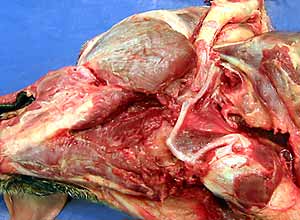 |
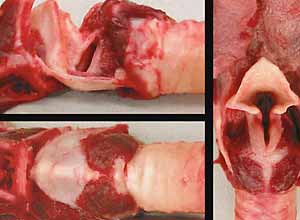 |
2 |
| 3 | 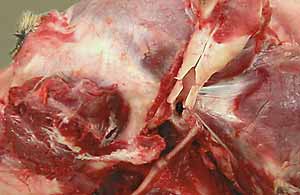 |
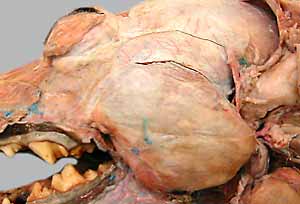 |
4 |
| 5 | 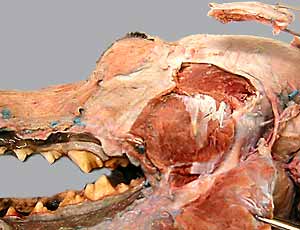 |
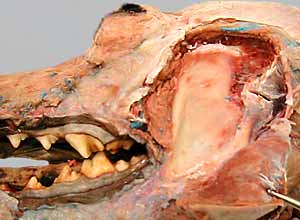 |
6 |
| 7 | 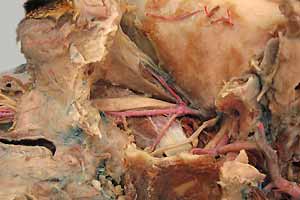 |
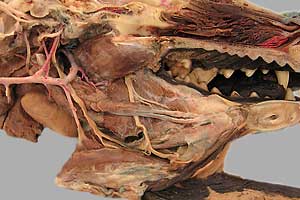 |
8 |
| 9 | 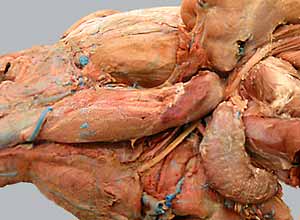 |
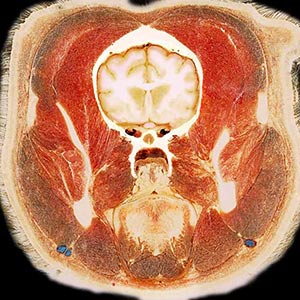 |
10 |
| 11 | 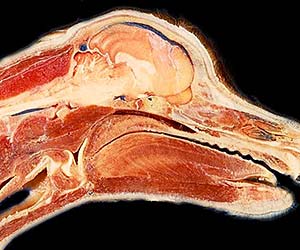 |
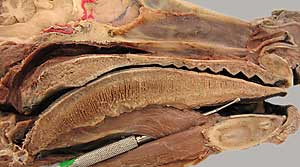 |
12 |
| 13 | 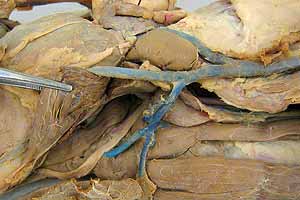 |
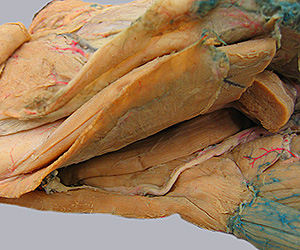 |
14 |